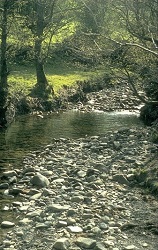Current ISIS code: W114
Previous assemblage name: Composed of W112 stony river margin & W121 sandy river margin.
Linked assemblage: W111 shingle bank.
Description of habitat typically supporting the assemblage: This SAT co-habits shingle banks with W111, but also occurs more widely along river and stream margins including shaded and sandy sections. The larvae may be aquatic or at least hygrophilous and not necessarily thermophilic. They are probably sensitive to riparian management, changes in flow regimes, siltation and increases in nutrient load.

and streams passing though floodplains with sand as a major component, and appears to be restricted to the west and north of Britain. Such floodplains may also receive additional sand from riverine deposits although where the underlying soils are not sandy these are insufficiently well developed to support the assemblage. There may be coarser particles (pebbles, cobbles) in the same river corridor, so this assemblage is merged with the former Stony river margin (W112) .
The soils are often shaded by willows or tall herbs, and this humid shade appears to be an essential part of the habitat for Tipula and Nephrotoma species, although perhaps less so for many of the smaller crane flies. The soils are damp or saturated and may be vegetated or bare. It is unclear whether closely vegetated areas are unsuitable as larval habitat, but tall sparse herbs, such as Himalayan balsam or nettles, do not appear to be disadvantageous.

The larvae of most of the crane flies are either semi-aquatic or live within the saturated to damp soil. The larvae of the shore flies Hecamedoides unispinosus and Polytrichophora duplosetosa are likely to be semi-aquatic at the water margin. Most of the characteristic species appear to be restricted to this assemblage and several can occur together, but Arctoconopa melampodia also occurs in Seepage assemblages on soft rock cliffs, and the aquatic larvae of the horsefly Tabanus cordiger may occur in more stony rivers too. Adults of many of the empids are found on stones, which may be moss-covered, protruding from the river as well as at the water margin of the shore.
The larvae of the empids Chelifera, Heleodromia, Hemerodromia and Wiedemannia, and the rhagionid Chrysopilus erythrophthalmus are completely aquatic, living on the river bed or perhaps in wet moss, and their adults remain at or close to the river margin. Amphibious species clearly associated with wet or damp stony margins include Lonchoptera nigrociliata, Oxycera terminata and Dixa maculata. The larval habitats of most of the remaining flies are poorly understood but are likely to be saturated soils or wet surfaces at the water margin. At least one species, Melanostolus melancholichus, also occurs in seepage assemblages on soft rock cliffs.
Sampling & assessing the assemblage
Standard sampling protocols apply
Target groups: Diptera
Fieldwork methods: Sweeping
Alternative methods: Suction sampling
Season: Spring-Summer
Being a predominantly fly-based assemblage, sweeping or timed suction sampling at the principal tools for sampling the finer sediment areas around ERS. Whilst a number of species will be on open silty areas or the stream edge, adults of others will be in riparian vegetation or even in flanking scrub, where they can be swept for foliage. It can be as much about shade as openness, and the full range of ERS sub-habitats should be sampled.
Discrimination of conservation quality: good
Default target: 6 species
